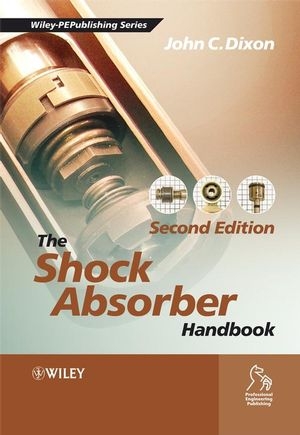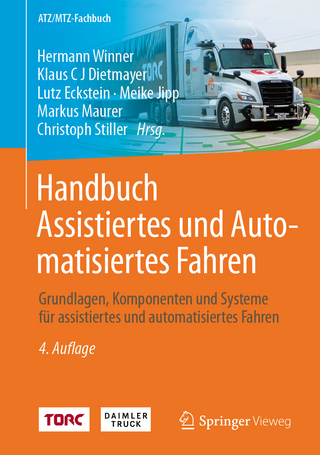
The Shock Absorber Handbook
John Wiley & Sons Inc (Verlag)
978-0-470-51020-9 (ISBN)
Every one of the many millions of cars manufactured annually worldwide uses shock absorbers, otherwise known as dampers. These form a vital part of the suspension system of any vehicle, essential for optimizing road holding, performance and safety. This, the second edition of the Shock Absorber Handbook (first edition published in 1999), remains the only English language book devoted to the subject. Comprehensive coverage of design, testing, installation and use of the damper has led to the book's acceptance as the authoritative text on the automotive applications of shock absorbers. In this second edition, the author presents a thorough revision of his book to bring it completely up to date. There are numerous detail improvements, and extensive new material has been added particularly on the many varieties of valve design in the conventional hydraulic damper, and on modern developments such as electrorheological and magnetorheological dampers.
"The Shock Absorber Handbook, 2nd Edition" provides a thorough treatment of the issues surrounding the design and selection of shock absorbers. It is an invaluable handbook for those working in industry, as well as a principal reference text for students of mechanical and automotive engineering.
Dr John C. Dixon, Eur. Ing., M.A., Ph.D., C.Eng, C.Phys, FIMechE, FRAeS, MinstP, MIET, is a Senior Lecturer at the Open University. He has extensive experience in vehicle dynamics, including shock absorber design and testing for leading racing teams. His previous books include “Tires, Suspension and Handling” and “The High Performance Two Stroke Engine”.
Preface xiii
Acknowledgements xv
1 Introduction 1
1.1 History 1
1.2 Types of Friction 15
1.3 Damper Configurations 17
1.4 Ride-Levelling Dampers 33
1.5 Position-Dependent Dampers 35
1.6 General Form of the Telescopic Damper 37
1.7 Mountings 42
1.8 Operating Speeds and Strokes 47
1.9 Manufacture 53
1.10 Literature Review 54
2 Vibration Theory 61
2.1 Introduction 61
2.2 Free Vibration Undamped (1-dof) 61
2.3 Free Vibration Damped (1-dof) 63
2.4 Forced Vibration Undamped (1-dof) 68
2.5 Forced Vibration Damped (1-dof) 71
2.6 Coulomb Damping 74
2.7 Quadratic Damping 77
2.8 Series Stiffness 79
2.9 Free Vibration Undamped (2-dof) 85
2.10 Free Vibration Damped (2-dof) 85
2.11 The Resonant Absorber 86
2.12 Damper Models in Ride and Handling 87
2.13 End Frequencies 88
2.14 Heave and Pitch Undamped 1-dof 90
2.15 Heave and Pitch Damped 1-dof 91
2.16 Roll Vibration Undamped 93
2.17 Roll Vibration Damped 94
2.18 Heave-and-Pitch Undamped 2-dof 95
2.19 Heave-and-Pitch Damped 2-dof Simplified 100
2.20 Heave-and-Pitch Damped 2-dof Full Analysis 102
3 Ride and Handling 105
3.1 Introduction 105
3.2 Modelling the Road 105
3.3 Ride 111
3.4 Time-Domain Ride Analysis 113
3.5 Frequency-Domain Ride Analysis 117
3.6 Passenger on Seat 118
3.7 Wheel Hop 119
3.8 Handling 120
3.9 Axle Vibrations 122
3.10 Steering Vibrations 124
3.11 The Ride–Handling Compromise 124
3.12 Damper Optimisation 129
3.13 Damper Asymmetry 131
4 Installation 135
4.1 Introduction 135
4.2 Motion Ratio 135
4.3 Displacement Method 137
4.4 Velocity Diagrams 138
4.5 Computer Evaluation 138
4.6 Mechanical Displacement 138
4.7 Effect of Motion Ratio 139
4.8 Evaluation of Motion Ratio 142
4.9 The Rocker 142
4.10 The Rigid Arm 148
4.11 Double Wishbones 150
4.12 Struts 153
4.13 Pushrods and Pullrods 155
4.14 Motorcycle Front Suspensions 156
4.15 Motorcycle Rear Suspensions 160
4.16 Solid Axles 165
4.17 Dry Scissor Dampers 168
5 Fluid Mechanics 169
5.1 Introduction 169
5.2 Properties of Fluids 170
5.3 Chemical Properties 171
5.4 Density 171
5.5 Thermal Expansion 172
5.6 Compressibility 172
5.7 Viscosity 173
5.8 Thermal Capacity 175
5.9 Thermal Conductivity 176
5.10 Vapour Pressure 176
5.11 Gas Density 176
5.12 Gas Viscosity 177
5.13 Gas Compressibility 177
5.14 Gas Absorbability 177
5.15 Emulsification 179
5.16 Continuity 188
5.17 Bernoulli’s Equation 188
5.18 Fluid Momentum 189
5.19 Pipe Flow 191
5.20 Velocity Profiles 196
5.21 Other Losses 199
5.22 The Orifice 203
5.23 Combined Orifices 207
5.24 Vortices 209
5.25 Bingham Flow 212
5.26 Liquid–Solid Suspensions 212
5.27 ER and MR Fluids 214
6 Valve Design 217
6.1 Introduction 217
6.2 Valve Types 219
6.3 Disc Valves 220
6.4 Rod Valves 221
6.5 Spool Valves 222
6.6 Shim Valves 223
6.7 Valve Characteristics 225
6.8 Basic Valve Models 227
6.9 Complete Valve Models 230
6.10 Solution of Valve Flow 235
6.11 Temperature Compensation 237
6.12 Position-Sensitive Valves 240
6.13 Acceleration-Sensitive Valves 240
6.14 Pressure-Rate Valves 243
6.15 Frequency-Sensitive Valves 245
6.16 Stroke-Sensitive Valves 245
6.17 Piezoelectric Valves 249
6.18 Double-Acting Shim Valves 249
6.19 Rotary Adjustables 250
6.20 Bellows Valves 252
6.21 Simple Tube Valves 252
6.22 Head Valves 257
6.23 Multi-Stage Valves 257
7 Damper Characteristics 259
7.1 Introduction 259
7.2 Basic Damper Parameters 263
7.3 Mechanical Friction 265
7.4 Static Forces 268
7.5 Piston Free Body Diagram 269
7.6 Valve Flow Rates 271
7.7 Pressures and Forces 272
7.8 Linear Valve Analysis 273
7.9 Cavitation 274
7.10 Temperature 276
7.11 Compressibility 276
7.12 Cyclical Characteristics, F(X) 278
7.13 Extreme Cyclic Operation 282
7.14 Stresses and Strains 283
7.15 Damper Jacking 286
7.16 Noise 287
8 Adjustables 289
8.1 Introduction 289
8.2 The Adjustable Valve 290
8.3 Parallel Hole 294
8.4 Series Hole 294
8.5 Maximum Area 294
8.6 Opening Pressure 294
8.7 Area Coefficient (Stiffness) 295
8.8 Automatic Systems 295
8.9 Fast Adaptive Systems 299
8.10 Motion Ratio 301
9 ER and MR Dampers 303
9.1 Introduction 303
9.2 ER–MR History 303
9.3 ER Materials 309
9.4 ER Dampers 314
9.5 ER Controlled Valve 319
9.6 MR Materials 321
9.7 MR Dampers 324
10 Specifying a Damper 333
10.1 Introduction 333
10.2 End Fittings 334
10.3 Length Range 334
10.4 F(V) Curve 334
10.5 Configuration 334
10.6 Diameter 335
10.7 Oil Properties 335
10.8 Life 335
10.9 Cost 335
11 Testing 337
11.1 Introduction 337
11.2 Transient Testing 338
11.3 Electromechanical Testers 342
11.4 Hydraulic Testers 344
11.5 Instrumentation 345
11.6 Data Processing 346
11.7 Sinusoidal Test Theory 348
11.8 Test Procedure 352
11.9 Triangular Test 354
11.10 Other Laboratory Tests 356
11.11 On-Road Testing 357
Appendix A: Nomenclature 361
Appendix B: Properties of Air 375
Appendix C: Properties of Water 379
Appendix D: Test Sheets 381
Appendix E: Solution of Algebraic Equations 385
Appendix F: Units 393
Appendix G: Bingham Flow 397
References 401
Index 409
| Erscheint lt. Verlag | 1.10.2007 |
|---|---|
| Reihe/Serie | Wiley PEPublishing |
| Verlagsort | New York |
| Sprache | englisch |
| Maße | 175 x 249 mm |
| Gewicht | 907 g |
| Themenwelt | Technik ► Fahrzeugbau / Schiffbau |
| Technik ► Maschinenbau | |
| ISBN-10 | 0-470-51020-X / 047051020X |
| ISBN-13 | 978-0-470-51020-9 / 9780470510209 |
| Zustand | Neuware |
| Haben Sie eine Frage zum Produkt? |
aus dem Bereich


